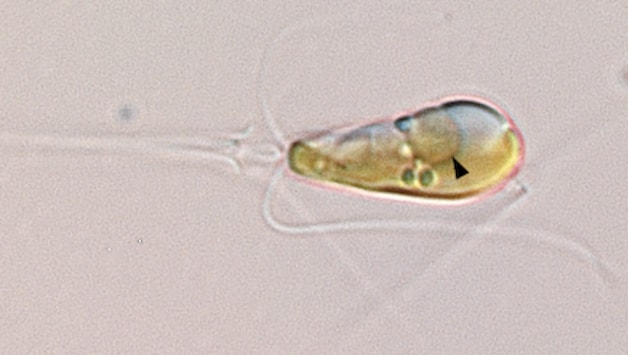Scientists have observed an evolutionary event that occurs only once in a billion years: two life forms merged into one organism that has special abilities. The last time this happened, the earth got plants.
It’s one of the rarest processes in evolution – and without it we wouldn’t exist. In a few exceptional cases, cells can transform a foreign organism into their own organ. When it first happened, in the early days of life, mitochondria emerged, without whose energy production there would be no higher life forms. Later, a cyanobacterium formed the chloroplasts, which plants use to collect solar energy.
Now another organism has crossed the border from symbiosis to cell building block, reports the team led by Tyler H. Coale and Valentina Loconte from the University of California. According to their publication in the journal Science, a cyanobacterium has lost its independence and is now producing ammonia as an organelle for the alga Braarudosphaera bigelowii. This makes Braarudosphaera and its relatives the only known higher organisms that can independently use the nitrogen in the air.
To illustrate: Imagine our kidneys were little animals walking around. And we humans would have to manually filter our blood through a dialysis machine. One day, one of these kidney animals somehow gets stuck in a person’s body (however that could work) and he finds that he no longer needs his dialysis machine. Neither will his children, until eventually we are all born with these helpful little guys inside us. That’s pretty much what’s happening here.
Until now, only bacteria had the ability to independently use the nitrogen in the air. Atmospheric nitrogen (N 2 ) is chemically extremely stable and can only be cracked by special metalloenzymes which, in addition to iron, also contain the metals molybdenum or vanadium, which are rare in biology. This is biochemically very complex. That’s why most bacteria capable of this live as symbionts in other organisms that provide them with other nutrients in exchange for ammonia – for example in the roots of beans and peas. The organelles of Braarudosphaera, known as nitroplasts, were also once such symbionts – and it was less than 90 million years ago that they lost their independence.
In fact, experts long assumed that nitroplasts were still symbiotic bacteria. Because the boundary between symbiosis and cell component is fluid. Even real symbionts gradually lose genes that they no longer need thanks to their host, and after a while they can no longer exist independently. But the integration of nitroplasts in Braarudosphaera goes even further than that, as Coale and Loconte’s team discovered in their research. The former symbiont has not only lost its genes for photosynthesis and metabolism, but also contains genes and proteins from its host, adapts its size to the needs of the alga, is integrated into its cytoskeleton and divides with it in a strictly coordinated manner. All of these features are typical of classical organelles.
On the other hand, it may not have been that long ago that the bacterium crossed the border into an organelle. The nitroplasts still look so similar to free-living bacteria that they were long considered symbionts. Genetic studies show that algae and bacteria probably came together around 150 million years ago. At that time, nutrients in the oceans were extremely scarce. Around 90 million years ago, the symbionts were tightly bound to their respective hosts, so that they strictly followed their speciation in the course of evolution. In the millions of years that followed, they lost more and more genes and the host cell began to supply specialized proteins for their metabolism and integrated them into their cell structure. So both developed together from a community to a cell with a bonus organ.
The original for this article “Researchers observe an event that only occurs once in a billion years” comes from Spektrum.de.









